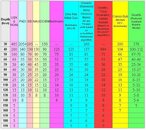I happen to own several computers, so I just checked a Galileo, a nitek Duo and two Oceanic (what I had near me)...and my normal dive buddy dives a Suunto.
Only the Oceanic matches the chart above.. the Galileo and the nitek Duo are both 19 minutes at 90 ft, and the Suunto is 17 minutes. The Suunto has adjustments to the next dive based on accent rates and surface interval (too short incurs an extra reduction on the next dive), while the Galileo has adjustments to the dive based on water temperature, breathing rate and if using the heart monitor, heart rate.
Oceanic has none of those on the two versions I have.
It is not so much the first dive, but if you continue making dives, the differences between say an Oceanic and Suunto (particularly if you have fast accents (more than 30 fpm) and a shorter surface interval than it likes (there is an icon to warn you) become rather amazing.
As we make a lot of dives together, if the Suunto diver follows the computer, and the Galileo diver does not exert themselves, the second 80 ft dive will have a difference of around 5 minutes. To a Oceanic, this would be over 20. But make any mistake with a Suunto, and the rest of the dives that day will be really short.
I believe the Unwatec also has some sort of penalty for rapid accents, but as I do trimix accents even when not on trimix, I don't see them.
What I notice is that there are places were tables work great (or memory) and there are places where tables suck. I remember last year, with the oil spill, where we would just go around until we found a spot to dive that did not involve diving thru oil...75ft.... 105.... 85 who knows. And your next dive would involve the same searching. We would all sit with our computers in planning mode for each spot, and adjust as needed.
But I have a major issue with trying to teach both. More and more I see divers that don't get enough time to learn even the basics.
This last Monday was a perfect example. On our boat we had one diver without a computer... so the boat loaned them one. The person stated they knew how to use it, but they also had PADI tables with them. The first dive was on a ledge... that has roughly 8 ft of relief... the bottom is at 86 ft and the top is around 78 ft. One can make the whole dive easily staying above 80 ft.. or one can look for stuff under ledges and go to the 86 ft level... or some pattern of that. The computer was a Uwatec prime.. so one could expect a dive between 22 and 28 minutes.
The diver joined us during the dive and my buddy, at the 28 minute mark, saw that our diver was still with us, and indicated to me he was going to take them up. I should note that the diver did not stay up on the high side of the ledge.
I continued on for my normal 50 minute dive... and went up with a friend that joined me for the rest of the dive.
On the surface he told me that the diver ascended without a safety stop, and seemed to be going up way to fast. The computer was locked out. When I asked what happened, I was told the computer locked out because they went up too fast, and then told me they did not actually understand what it was telling them.
So, thankfully they seemed ok, and did not do the next dive. The next dive is to the same depth, but on a wreck (so if one wants, they can stay above 70 ft). While we were doing our surface interval, a small private boat arrived and as we entered, so did they. My buddy and I did a 36 minute dive with an average depth of around 78 ft, and started our ascent... to our surprise, there were two new divers on our line with us (on air). I dropped down to make sure they had enough gas (as they had entered the water just before us) and notice the one diver had a 18 deco obligation...they did a 3 minute safety stop and surfaced, where they told the crew on our boat that their computers broke and then they swam back to their boat. Don't have a clue if they had any issues later.
I believe the total number of divers involved were 9 on our boat and 4 on the small boat...with two people that were trying really hard to get a DCS hit. Pretty clear they did not understand the computer, and equally clear they did not understand tables (our other diver commented that they were only below 80 ft for a portion of the dive.. so one can use 80 ft). I know there is no cure for some things, but doing trying to get these people to understand both systems would seem to be outside the range of all the instructors I know (including me).





